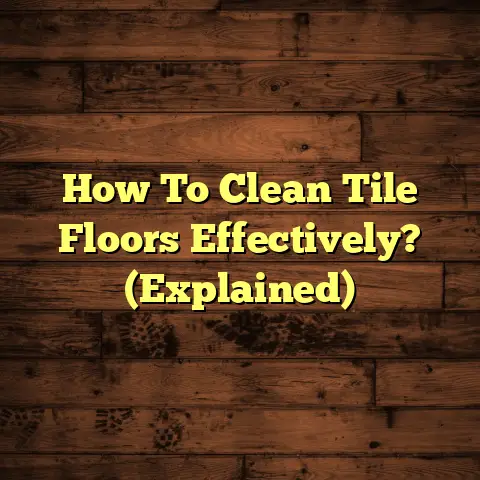Engineered Wood or Solid? (9 Reasons Why!)
Do you remember that feeling? The warmth of the holidays, the smell of pine, the sound of laughter echoing through the house? I do.
And I especially remember the feel of the solid oak floors beneath my feet, worn smooth by generations of family gatherings. That floor was home.
Choosing the right flooring is a big deal. It sets the tone for your entire home. It’s about more than just looks; it’s about durability, maintenance,
and, let’s be honest, the dent it’ll make in your wallet. Today, we’re diving headfirst into the epic showdown: engineered wood versus solid wood flooring.
I’m going to walk you through nine crucial reasons why one might be the perfect fit for your life and home. Let’s get started!
1. Understanding Engineered Wood and Solid Wood
Okay, so what are we even talking about here?
Solid wood flooring is exactly what it sounds like: planks milled from a single piece of hardwood. Think oak, maple, cherry, walnut – the classics.
It’s been around for centuries, a testament to its durability and timeless appeal. It’s the OG of flooring, if you will.
Engineered wood flooring, on the other hand, is a bit more complex. It’s made up of layers. The top layer is a veneer of real hardwood.
Underneath that, you’ll find multiple layers of plywood or high-density fiberboard (HDF), bonded together. This construction gives it some serious
stability, which we’ll get into later. It’s the modern marvel, designed for real life.
Historically, solid wood was the only option. But as technology advanced, so did our flooring options. Engineered wood emerged as a solution to
some of the limitations of solid wood, like its susceptibility to moisture and its tendency to expand and contract.
2. Aesthetic Appeal: Beauty is in the Eye…and the Floor
Let’s be real, looks matter!
Solid wood has that undeniable, classic beauty. The grain patterns, the natural variations in color, the feeling that it’s been around for a while –
it’s hard to replicate. It exudes warmth and character. Think of a beautifully restored Victorian home, with its original, gleaming hardwood floors.
Engineered wood has come a long way. You can find it in virtually any wood species, width, and finish you can imagine.
The top veneer is real hardwood, so you get the same visual appeal as solid wood. Plus, with advancements in texturing and finishing techniques, some engineered
wood floors can even mimic the look of reclaimed or hand-scraped solid wood. For example, you can now find engineered planks that perfectly emulate the
rustic charm of wide-plank, distressed oak, a look that’s incredibly popular right now.
Which one complements your style? Do you lean towards traditional elegance or modern minimalism? Solid wood fits seamlessly into classic, traditional, and
rustic designs. Engineered wood is incredibly versatile and can adapt to pretty much any style, from contemporary to farmhouse chic.
3. Durability and Longevity: Built to Last?
This is where the rubber meets the road. Or, should I say, where the foot meets the floor?
Solid wood is tough. It can withstand a lot of wear and tear. And the best part? You can refinish it multiple times. Sand it down, re-stain it, and it’s
like new again. I’ve seen solid wood floors that have lasted for over a century! However, it’s more susceptible to moisture damage.
Spills need to be cleaned up quickly, and it’s not ideal for bathrooms or basements. Solid wood expands and contracts with changes in humidity, which can lead
to warping, cupping, and gapping. I’ve seen floors buckle so badly they looked like waves!
Engineered wood shines here. That layered construction makes it incredibly stable. It’s less likely to warp or buckle in humid environments.
It can handle temperature fluctuations better than solid wood. While you can refinish some engineered wood floors, the number of times you can do it depends
on the thickness of the top veneer. A thicker veneer means more refinishing potential. The wear resistance is generally very good, and many engineered wood
floors come with durable factory finishes that resist scratches and stains. It’s a practical choice for busy households.
According to the National Wood Flooring Association, a well-maintained solid wood floor can last 100+ years, while a high-quality engineered wood floor can
last 25-50 years. (Source: NWFA Guidelines)
4. Installation Process: DIY or Hire a Pro?
Are you a weekend warrior or do you prefer to leave it to the professionals?
Solid wood installation is generally more complex. It typically involves nailing or gluing the planks to a subfloor. It requires specialized tools and a
good understanding of woodworking techniques. I wouldn’t recommend it for a beginner DIYer. It’s time-consuming and can be physically demanding.
Engineered wood offers more flexibility. Many engineered wood floors can be installed using a “floating” method, where the planks click together
and aren’t directly attached to the subfloor. This is much easier for DIYers. You can also glue or nail down engineered wood, depending on the product and
the manufacturer’s recommendations. The floating installation is faster and less messy than traditional nail-down methods.
The cost of installation varies depending on the method, the complexity of the project, and whether you hire a professional. Generally, engineered wood
installation is less expensive than solid wood installation, especially if you opt for the floating method. Labor costs for solid wood can easily be
double that of engineered wood, due to the extra time and skill required.
5. Maintenance and Care: Keeping it Clean
Let’s talk chores!
Solid wood requires regular cleaning to prevent dirt and grime from building up. Sweeping or vacuuming is essential. You’ll also need to use a wood floor
cleaner specifically designed for hardwood. Avoid excessive moisture, as it can damage the wood. Refinishing is a must every 10-20 years, depending
on wear and tear. The cost of refinishing can range from \$3 to \$8 per square foot. (Source: HomeAdvisor)
Engineered wood is generally easier to maintain. It’s more resistant to moisture, so you don’t have to be as paranoid about spills. Regular sweeping and
occasional damp mopping with a wood floor cleaner are usually sufficient. The need for refinishing depends on the thickness of the veneer.
If the veneer is thick enough, you can refinish it once or twice. If it’s a thin veneer, you might only be able to screen and recoat it. This is a
process that buffs the surface and applies a new coat of finish.
6. Environmental Impact: Going Green
Are you concerned about sustainability?
Solid wood can be a sustainable choice if it’s sourced from responsibly managed forests. Look for certifications like the Forest Stewardship Council
(FSC). However, harvesting old-growth forests can have a significant environmental impact. The carbon footprint of solid wood can be higher, especially if
it’s transported long distances. Waste is also a consideration. Solid wood flooring generates more waste during manufacturing and installation.
Engineered wood often utilizes fast-growing wood species for the core layers, which can be more sustainable. It also uses less hardwood than
solid wood, conserving valuable resources. Some engineered wood floors are made with recycled content. However, the adhesives used in the
manufacturing process can contain volatile organic compounds (VOCs), which can impact indoor air quality. Look for low-VOC or no-VOC products.
7. Cost Considerations: Show Me the Money!
Let’s get down to brass tacks.
Solid wood is generally more expensive than engineered wood. The cost of materials can range from \$5 to \$15 per square foot, depending on the
species, grade, and finish. Installation costs are also higher. The long-term investment value can be good, especially if you maintain the floors well.
Solid wood floors can increase the resale value of your home. (Source: Zillow)
Engineered wood is typically more budget-friendly. The cost of materials can range from \$3 to \$10 per square foot. Installation costs are lower, especially
if you DIY the project. While it may not have the same resale value as solid wood, it’s still a desirable feature for many homebuyers.
Consider the long-term costs as well. Solid wood requires more frequent refinishing, which can add up over time. Engineered wood may need to be replaced
sooner than solid wood, but the lower initial cost can offset that.
8. Performance in Different Environments: Location, Location, Location!
Where are you installing the floor?
Solid wood is best suited for rooms with stable humidity levels. Avoid installing it in bathrooms, basements, or kitchens where moisture is a concern.
It performs well in living rooms, dining rooms, and bedrooms. If you live in a climate with extreme temperature fluctuations, solid wood may not be the
best choice.
Engineered wood is much more versatile. It can be installed in a wider range of environments, including basements and kitchens. It’s more resistant
to moisture and temperature changes, making it a good choice for homes in humid climates. However, it’s still not waterproof. Avoid installing it in
areas that are constantly exposed to water, like bathrooms with leaky showers.
9. Personal Preference and Lifestyle: It’s All About You
What’s your life like?
Do you have kids? Pets? Do you entertain frequently? All of these factors can influence your flooring decision.
Solid wood is a great choice for homeowners who appreciate the timeless beauty and durability of natural wood. It’s a good fit for families who are
willing to invest in regular maintenance and care. If you have pets, be prepared for scratches and dents. Solid wood can be a good choice for formal
living spaces or bedrooms where you want to create a sense of elegance.
Engineered wood is a practical choice for busy families with kids and pets. It’s more resistant to scratches and stains. It’s also a good option for
homeowners who want a wood look without the high cost and maintenance of solid wood. It’s a versatile choice for any room in the house, from the living
room to the basement. If you entertain frequently, engineered wood can withstand heavy foot traffic.
In Conclusion:
So, which is the right choice for you? As you can see, there’s no one-size-fits-all answer. It really comes down to your individual needs, preferences, and
circumstances. Consider the aesthetic appeal, durability, installation process, maintenance requirements, environmental impact, cost, performance
in different environments, and your personal lifestyle. Weigh the pros and cons of each type of flooring and make an informed decision that aligns with your vision
for your home. And remember, I’m always here to help! If you have any questions, don’t hesitate to reach out. Happy flooring!





